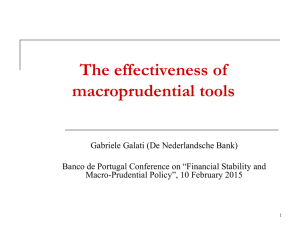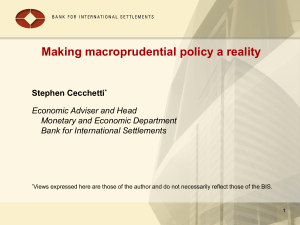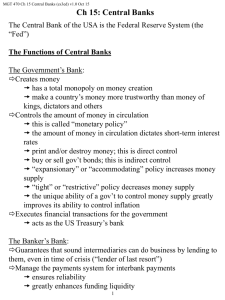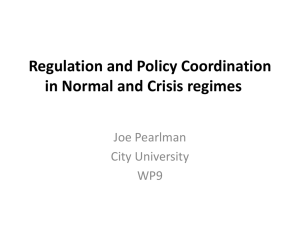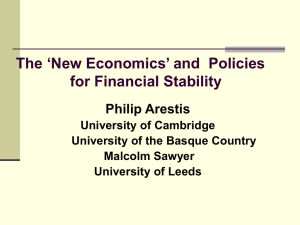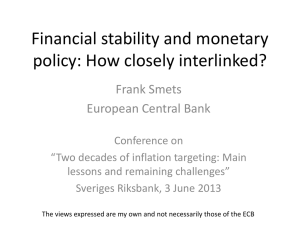Macroprudential policies – challenges for central banks
advertisement
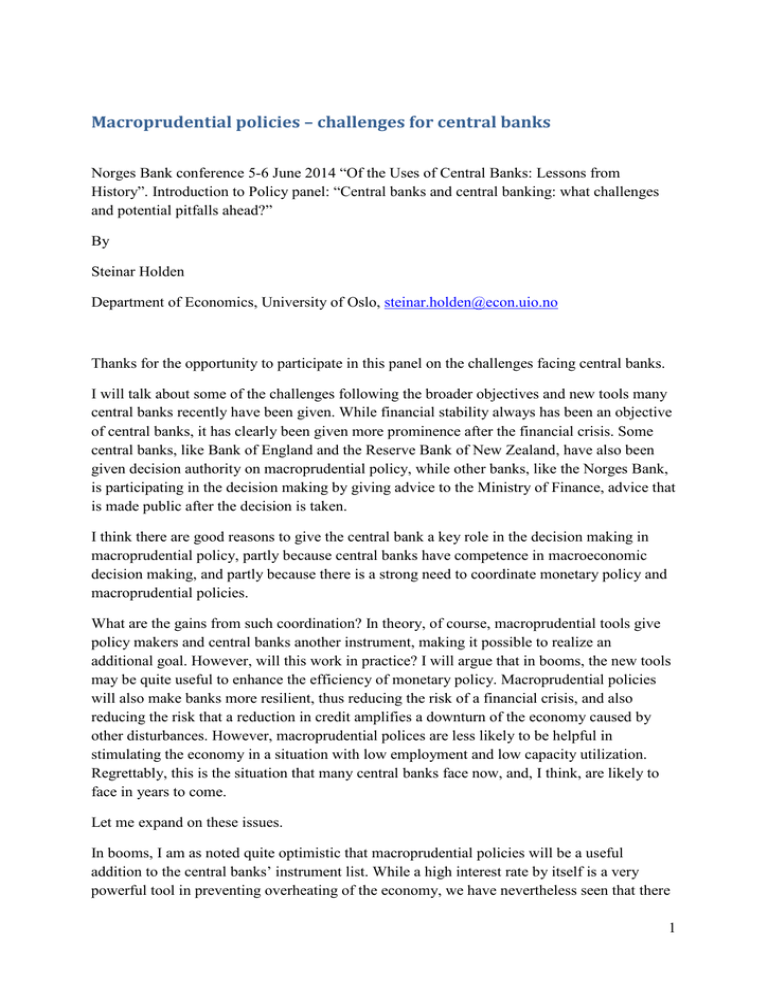
Macroprudential policies – challenges for central banks Norges Bank conference 5-6 June 2014 “Of the Uses of Central Banks: Lessons from History”. Introduction to Policy panel: “Central banks and central banking: what challenges and potential pitfalls ahead?” By Steinar Holden Department of Economics, University of Oslo, steinar.holden@econ.uio.no Thanks for the opportunity to participate in this panel on the challenges facing central banks. I will talk about some of the challenges following the broader objectives and new tools many central banks recently have been given. While financial stability always has been an objective of central banks, it has clearly been given more prominence after the financial crisis. Some central banks, like Bank of England and the Reserve Bank of New Zealand, have also been given decision authority on macroprudential policy, while other banks, like the Norges Bank, is participating in the decision making by giving advice to the Ministry of Finance, advice that is made public after the decision is taken. I think there are good reasons to give the central bank a key role in the decision making in macroprudential policy, partly because central banks have competence in macroeconomic decision making, and partly because there is a strong need to coordinate monetary policy and macroprudential policies. What are the gains from such coordination? In theory, of course, macroprudential tools give policy makers and central banks another instrument, making it possible to realize an additional goal. However, will this work in practice? I will argue that in booms, the new tools may be quite useful to enhance the efficiency of monetary policy. Macroprudential policies will also make banks more resilient, thus reducing the risk of a financial crisis, and also reducing the risk that a reduction in credit amplifies a downturn of the economy caused by other disturbances. However, macroprudential polices are less likely to be helpful in stimulating the economy in a situation with low employment and low capacity utilization. Regrettably, this is the situation that many central banks face now, and, I think, are likely to face in years to come. Let me expand on these issues. In booms, I am as noted quite optimistic that macroprudential policies will be a useful addition to the central banks’ instrument list. While a high interest rate by itself is a very powerful tool in preventing overheating of the economy, we have nevertheless seen that there 1 may be important limitations on the central bank’s ability to actually contain the expansion, even if there is a potential risk of a subsequent crisis. One limitation is that positive supply shocks like lower import prices may cause inflation to fall below the target value, making it difficult for the central bank to set sufficiently a high interest rate. Another limitation to the central bank’s ability to contain a boom lies in the effect on the exchange rate. A hike in the policy rate may lead to a strong appreciation of the exchange rate. This will of course further dampen inflation, exacerbating a potential problem of too low inflation, as well as causing problems for the traded sector. In such situations, macroprudential policies may be helpful. Countercyclical capital requirements and stricter loan-to-value requirements will dampen credit growth and dampen growth in the economy, reducing the need for a rise in interest rates. Moreover, increased capital requirements for banks are likely to reduce their lending, and increase their lending rates, without increasing the money market rates. Thus, there is less reason to expect an appreciation of the exchange rate, even if the interest rates facing borrowers is likely to increase. Clearly, there are limitations as to how much can be achieved. One reason lies in limitations on how much one can tighten the macroprudential policies, due to adverse side effects, among them distributional effects, and political concerns. Another limitation is that there might be leakages to other parts of the financial system that are less constrained. Yet there is evidence showing that macroprudential policies may be valuable to contain a boom, for example Lim et al (2011). However, one should remember that the financial cycle is likely to be of longer duration than the business cycle, implying that there will also be booms where the macroprudential policy is already tightened prior to the boom. What about the effects during a downturn, or when the economy already is in a situation with low employment and low capacity utilization? Clearly, macroprudential policies ensuring higher capital ratios of banks prior to the downturn will make them more resilient, reducing the risk of an adverse spiral where financial institutions for liquidity reasons are forced to sell assets, leading to increased risk and increased capital losses. Thus, macroprudential policies reduce the risk of a financial crisis, and they are also likely to reduce the negative amplification from the financial sector during a downturn of the economy. These are important gains, and clearly the most important justification for macroprudential policies. Also in downturns and weak cyclical states of the economy, there is a need to coordinate monetary policy and macroprudential policy. As we have learned – and not without costs – low interest rates may feed asset inflation and induce excessive risk taking in financial markets. In this situation, fairly stringent capital requirements will mitigate adverse side effects, and reduce the risk associated with low interest rates. In that way, sound macroprudential policies may make the monetary policy more efficient. Yet without coordination, there is a risk that the low interest rate will be met by too tight macroprudential policies, and too tight regulatory requirements. This might seriously weaken the stimulative effect of the low interest rate. 2 However, recent experiences in several countries have shown that in some situations, monetary policy for an extended period is unable to stimulate the economy sufficiently to get it out of a depressed situation with low employment and low capital utilization. The zero lower bound has proved to be a more important restriction on monetary policy than most central bankers and academics would have guessed in the past. In this situation, the tightening of the regulatory requirements has clearly had adverse effects on credit and demand, and, as such delayed the return to a normal state of the economy. It was undoubtedly necessary to tighten regulatory requirements in the wake of the financial crisis, but it is more difficult to know how fast it should have been done. In a mature system with macroprudential policies, the requirements are supposed to be loosened if the economy weakens sufficiently. Less strict countercyclical capital requirements and loan-to-value requirements are supposed to stimulate the economy. However, we have less experience from the use of such policies. Moreover, when the economy weakens, financial markets may require higher capital ratios from financial institutions, making it difficult for banks to keep up their lending, even if looser regulatory requirements would make it possible. It is unclear to what extent looser requirements will work to stimulate a depressed economy. As noted, I think that low employment and low capacity utilization will be important problems facing many central banks in years to come. As argued by a number of scholars (e.g. Summers, 2014), there are several reasons why one might expect aggregate demand to be quite low in the future. One reason is low investment levels in the business sector, in the wake of the financial crisis. Investors seem to require high rates of return, and combined with low capacity utilization, this leads to low investment levels. Another reason is high debt levels, leading to the need for deleveraging. A third reason is increased income inequality, where a greater share of total incomes goes to the super rich. Kumhof et al (2013) show that in the US, the income share of the top five percent increased from 23 percent in 1983 to 34 percent in 2007. As one would expect, the super rich save a greater share of their income, thus aggregate consumption goes down, leading to a significant reduction in aggregate demand. In an economy with low employment and low capacity utilization, keeping the interest rate low is crucial. However, as argued above, the zero lower bound has proven to be a real constraint on the policy, and one cannot expect too much from so-called unconventional monetary policy, even if one has to try. Macroprudential policy is useful to increase the resilience of the financial system, thus reducing the risk of adverse consequences of the low interest rate, but it is unlikely to stimulate the economy sufficiently. Let me end by a potential pitfall for central banks. Even in an economy with low employment levels, there will be fluctuations in inflation and wage growth. And one of the mistakes a central bank can do, is to be too fast in raising the interest rate when there are signs of higher growth and higher prices. Even if employment is considerably below the long run potential, a period of rapid growth with increasing profits and new jobs may lead to a rise in wage growth 3 and emerging inflationary pressure. However, a premature interest rate increase may dampen growth and prevent employment from reaching its potential. In traditional monetary policy analysis, there is an underlying proposition that monetary policy cannot affect real variables in the long run. Thus, the policy tradeoff is between variability in inflation and variability in output or employment. However, this description of the policy tradeoff is based on a highly questionable underlying assumption that the business cycle fluctuations must sum to zero over time. Thus, periods of employment below the potential or equilibrium level are compensated by corresponding periods of employment above the potential level. This assumption is unlikely to be true, because severe or long lasting downturns are not likely to be fully compensated by higher output and employment in preceding or subsequent periods. To illustrate with a simple numerical example: If equilibrium unemployment is 6 percent, periods with 10 or 12 percent unemployment are unlikely to be compensated by equally long periods with 2 or 0 percent unemployment. Thus, severe or long lasting downturns will imply a reduction in the average output and employment over time. 1 My conclusion is thus that in an economy with a low employment level, the central bank should be careful not to tighten monetary policy too early, even if inflation or wage growth increase. Starting out from a situation with low employment and a low wage share, one would expect a temporary rise in wage growth. However, workers and unions have a much weaker bargaining position than before, because of globalization, tougher employers and reduced union membership. Wage setters are well aware that the central bank will raise the interest rate to realize the inflation target. It is difficult to see that high wage growth will persist, if employment is low and the central bank increases the interest rate. When unions and workers are weaker than before, the risk that a rise in inflation expectations will make inflation persistent is much lower than before. In models with sticky prices, higher inflation expectations make firms raise prices to avoid being stuck with too low prices. In reality, competition at the product market makes most firms reluctant to raise prices before their competitors. Thus, the link between inflation expectations and price setting is likely to be much weaker than theory predicts. And if inflation expectations emerge in financial markets, it will raise long term interest rates, reducing the risk of persistent inflation. When employment is low, there may also be an important asymmetry in the choice set of the central bank. If the central bank errs on the tight side, and the economy weakens further, the zero lower bound may kick in and prevent the central bank from stimulating the economy sufficiently. In contrast, if the central bank errs on the loose side, and inflation persists above target, the central bank can always raise the interest rate as much as is required to push inflation down. 1 In addition, hysteresis effects in the labor market or in capital formation may imply that temporary negative shocks have long lasting or permanent effects on potential output. On the conceptual level, this is very different from the point in the main text, which is that the sum of temporary shocks may differ from zero. However, in practice it may be difficult to distinguish between these two types of effects. See Reifschneider et al (2013) and Hall (2014) for empirical research on the lasting effects of the financial crisis to the US economy. 4 The increase in the interest rate by the ECB in 2011 is probably a good example of a premature rise in the policy rate, which probably has had a negative impact on the average employment level in the euro area over 5 or 10 year period. 2 The ECB is now facing the risk of deflation, and is constrained by the zero lower bound, even if the bank entered the negative area for the deposit rate in June 2014. If the ECB had maintained the low interest and inflation had increased, the bank could now easily have raised the interest rate to push inflation down. In advanced economies, the interest rate is a very powerful tool, and central banks can afford to let a depressed economy grow, as inflation can be restrained later on. References Hall, R.E. (2014). Quantifying the lasting harm to the U.S. economy from the financial crisis, NBER Macro Annual 2014, forthcoming. Holden, S. (2011) ”Konjunkturer og økonomisk politikk”. In Finansråd i utfordrende tider, N. Bjerkedal (ed) Finansdepartementet, p 14-21. Lim, C, and F. Columba, A. Costa, P. Kongsamut, A. Otani, M. Saiyid, T. Wezel, and X. Wu (2011). Macroprudential policy: What instruments and how to use them? IMF working paper 11/238. Kumhof, M., R. Ranciere and P. Winant (2013) Inequality, Leverage and Crises: The Case of Endogenous Default. IMF working paper 13/249. Reifschneider, D. , W.L. Wascher and D. Wilcox (2013). Aggregate supply in the United States: Recent developments and implications for the conduct of monetary policy. Paper presented at the 14th Jacques Polak Annual Research Conference. Summers, L. (2014) Secular stagnation. http://larrysummers.com/secular-stagnation/ 2 Let me add that this is not only an ex post argument – I made the same argument in April 2011, see Holden (2011). 5
